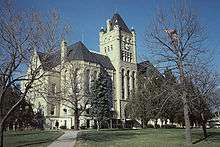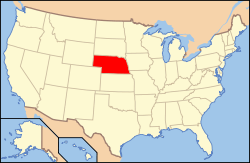Gage County, Nebraska
| Gage County, Nebraska | |
|---|---|
 Gage County Courthouse in Beatrice, 2009 | |
 Location in the U.S. state of Nebraska | |
 Nebraska's location in the U.S. | |
| Founded | 1857 |
| Seat | Beatrice |
| Largest city | Beatrice |
| Area | |
| • Total | 860 sq mi (2,227 km2) |
| • Land | 852 sq mi (2,207 km2) |
| • Water | 8.5 sq mi (22 km2), 1.0% |
| Population | |
| • (2010) | 22,311 |
| • Density | 10/sq mi (4/km²) |
| Congressional district | 3rd |
| Time zone | Central: UTC-6/-5 |
| Website |
www |
Gage County is a county in the U.S. state of Nebraska. As of the 2010 census, the population was 22,311.[1] Its county seat is Beatrice.[2] The county was created in 1855 and organized in 1857.[3][4][5] It was formed from land taken from the Oto in an 1854 treaty and named for W.D. Gage, a Methodist minister.[6][7]
Gage County comprises the Beatrice, NE Micropolitan Statistical Area, which is also in the Lincoln-Beatrice, NE Combined Statistical Area.
In the Nebraska license plate system, Gage County is represented by the prefix 3 (it had the third-largest number of vehicles registered in the county when the license plate system was established in 1922).
Geography
According to the U.S. Census Bureau, the county has a total area of 860 square miles (2,200 km2), of which 851 square miles (2,200 km2) is land and 8.5 square miles (22 km2) (1.0%) is water.[8]
Major highways
Adjacent counties
- Lancaster County - north
- Otoe County - northeast
- Johnson County - northeast
- Pawnee County - southeast
- Marshall County, Kansas - southeast
- Washington County, Kansas - southwest
- Jefferson County - west
- Saline County - northwest
National protected area
Demographics
| Historical population | |||
|---|---|---|---|
| Census | Pop. | %± | |
| 1860 | 421 | — | |
| 1870 | 3,359 | 697.9% | |
| 1880 | 13,164 | 291.9% | |
| 1890 | 36,344 | 176.1% | |
| 1900 | 30,051 | −17.3% | |
| 1910 | 30,325 | 0.9% | |
| 1920 | 29,721 | −2.0% | |
| 1930 | 30,242 | 1.8% | |
| 1940 | 29,588 | −2.2% | |
| 1950 | 28,052 | −5.2% | |
| 1960 | 26,818 | −4.4% | |
| 1970 | 25,731 | −4.1% | |
| 1980 | 24,456 | −5.0% | |
| 1990 | 22,794 | −6.8% | |
| 2000 | 22,993 | 0.9% | |
| 2010 | 22,311 | −3.0% | |
| Est. 2015 | 21,900 | [9] | −1.8% |
| U.S. Decennial Census[10] 1790-1960[11] 1900-1990[12] 1990-2000[13] 2010-2013[1] | |||
As of the census[14] of 2000, there were 22,993 people, 9,316 households, and 6,204 families residing in the county. The population density was 27 people per square mile (10/km²). There were 10,030 housing units at an average density of 12 per square mile (5/km²). The racial makeup of the county was 97.69% White, 0.32% Black or African American, 0.58% Native American, 0.28% Asian, 0.03% Pacific Islander, 0.26% from other races, and 0.84% from two or more races. 0.85% of the population were Hispanic or Latino of any race. 56.6% were of German, 6.9% Irish, 6.3% English and 6.3% American ancestry according to Census 2000.
There were 9,316 households out of which 30.30% had children under the age of 18 living with them, 56.70% were married couples living together, 7.10% had a female householder with no husband present, and 33.40% were non-families. 29.20% of all households were made up of individuals and 15.00% had someone living alone who was 65 years of age or older. The average household size was 2.36 and the average family size was 2.91.
In the county the population was spread out with 24.00% under the age of 18, 7.70% from 18 to 24, 26.30% from 25 to 44, 22.80% from 45 to 64, and 19.20% who were 65 years of age or older. The median age was 40 years. For every 100 females there were 94.10 males. For every 100 females age 18 and over, there were 91.40 males.
The median income for a household in the county was $34,908, and the median income for a family was $43,072. Males had a median income of $29,680 versus $21,305 for females. The per capita income for the county was $17,190. About 6.60% of families and 8.70% of the population were below the poverty line, including 9.70% of those under age 18 and 8.00% of those age 65 or over.
Communities
Cities
- Beatrice (county seat)
- Blue Springs
- Wymore
Villages
Census-designated place
Unincorporated communities
Townships
See also
References
- 1 2 "State & County QuickFacts". United States Census Bureau. Retrieved September 20, 2013.
- ↑ "Find a County". National Association of Counties. Retrieved 2011-06-07.
- ↑ Fitzpatrick, Lilian Linder (1925). Nebraska Place-Names. Lincoln: University of Nebraska Studies in Language, Literature, and Criticism. p. 63. Retrieved December 18, 2014.
- ↑ Andreas, A. T. (1882). "Andreas' History of the State of Nebraska". The Kansas Collection. Retrieved December 18, 2014.
- ↑ "Gage County". Nebraska Association of County Officials. Retrieved December 18, 2014.
- ↑ Gage County History (archived)
- ↑ Gannett, Henry (1905). The Origin of Certain Place Names in the United States. Govt. Print. Off. p. 133.
- ↑ "2010 Census Gazetteer Files". United States Census Bureau. August 22, 2012. Retrieved December 7, 2014.
- ↑ "County Totals Dataset: Population, Population Change and Estimated Components of Population Change: April 1, 2010 to July 1, 2015". Retrieved July 2, 2016.
- ↑ "U.S. Decennial Census". United States Census Bureau. Retrieved December 7, 2014.
- ↑ "Historical Census Browser". University of Virginia Library. Retrieved December 7, 2014.
- ↑ "Population of Counties by Decennial Census: 1900 to 1990". United States Census Bureau. Retrieved December 7, 2014.
- ↑ "Census 2000 PHC-T-4. Ranking Tables for Counties: 1990 and 2000" (PDF). United States Census Bureau. Retrieved December 7, 2014.
- ↑ "American FactFinder". United States Census Bureau. Retrieved 2008-01-31.
External links
| Wikimedia Commons has media related to Gage County, Nebraska. |
 |
Saline County | Lancaster County | Otoe County and Johnson County |  |
| Jefferson County | |
|||
| ||||
| | ||||
| Washington County, Kansas | Pawnee County and Marshall County, Kansas |
Coordinates: 40°16′N 96°41′W / 40.27°N 96.69°W